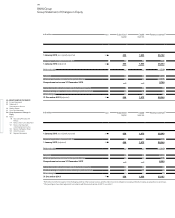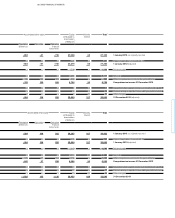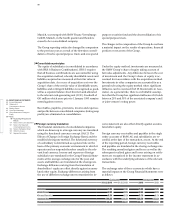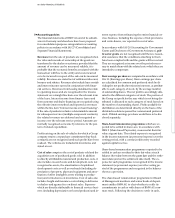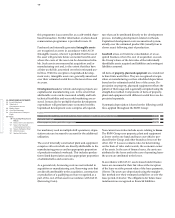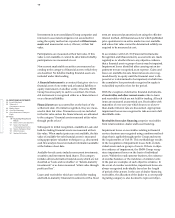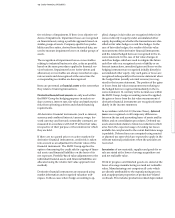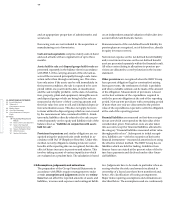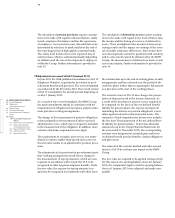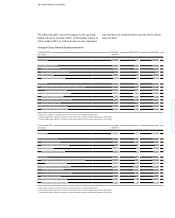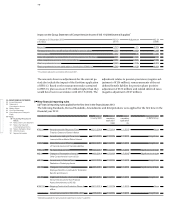BMW 2013 Annual Report Download - page 101
Download and view the complete annual report
Please find page 101 of the 2013 BMW annual report below. You can navigate through the pages in the report by either clicking on the pages listed below, or by using the keyword search tool below to find specific information within the annual report.
101 GROUP FINANCIAL STATEMENTS
Where Group products are recognised by BMW Group
entities as leased products under operating leases, they
are measured at manufacturing cost. All other leased
products are measured at acquisition cost. All leased
products are depreciated over the period of the lease
using the straight-line method down to their expected
residual value. Changes in residual value expectations
are recognised – in situations where the recoverable
amount of the lease exceeds the carrying amount of
the asset – by adjusting scheduled depreciation
pro-
spectively over the remaining term of the lease
contract. If the recoverable amount is lower than the
expected residual value, an impairment loss is recog-
nised for the shortfall. A test is carried out at each
balance sheet date to determine whether an impair-
ment loss recognised in prior years no longer exists
or has decreased. In these cases, the carrying amount
of the asset is increased to the recoverable amount.
The higher carrying amount resulting from the rever-
sal may not, however, exceed the rolled-forward amor-
tised cost of the asset.
If there is any evidence of impairment of non-financial
assets (except inventories and deferred taxes), or if an
annual impairment test is required to be carried out –
i. e. for intangible assets not yet available for use, intan-
gible assets with an indefinite useful life and goodwill
acquired as part of a business combination – an impair-
ment test pursuant to IAS 36 (Impairment of Assets)
is performed. Each individual asset is tested separately
unless the asset generates cash flows that are largely
independent of the cash flows from other assets or
groups of assets (cash-generating units / CGUs). For the
purposes of the impairment test, the asset’s carrying
amount is compared with its recoverable amount, the
latter defined as the higher of the asset’s fair value less
costs to sell and its value in use. An impairment loss
is
recognised when the recoverable amount is lower than
the asset’s carrying amount. Fair value is the price that
would be received to sell an asset in an orderly trans-
action between market participants at the measurement
date. The value in use corresponds to the present value
of future cash flows expected to be derived from an asset
or groups of assets.
The first step of the impairment test is to determine the
value in use of an asset. If the calculated value in use is
lower than the carrying amount of the asset, then its
fair value less costs to sell are also determined. If the lat-
ter is also lower than the carrying amount of the asset,
then an impairment loss is recorded, reducing the car-
rying
amount to the higher of the asset’s value in use
or fair value less costs to sell. The value in use is deter-
mined on the basis of a present value computation.
Cash flows used for the purposes of this calculation are
derived from long-term forecasts approved by manage-
ment.
The long-term forecasts themselves are based on
detailed forecasts drawn up at an operational level
and, based on a planning period of six years, correspond
roughly to a typical product’s life-cycle. For the purposes
of calculating cash flows beyond the planning period,
the asset’s assumed residual value does not take growth
into account. Forecasting assumptions are continually
brought up to date and regularly compared with exter-
nal sources of information. The assumptions used take
account in particular of expectations of the profitability
of the product portfolio, future market share
develop-
ments, macro-economic developments (such as currency,
interest rate and raw materials) as well as the legal
en-
vironment and past experience. Cash flows of the Auto-
motive and Motorcycles CGUs are discounted using a
risk-adjusted pre-tax weighted average cost of capital
(WACC) of 12.0 % (2012: 12.0 %). In the case of the Finan-
cial Services CGU, a sector-compatible pre-tax cost of
equity capital of 13.4 % (2012: 13.4 %) is applied. In con-
junction with the impairment tests for CGUs, sensitivity
analyses are performed for the main assumptions.
Analyses performed in the year under report confirmed,
as in the previous year, that no impairment loss was re-
quired to be recognised.
If the reason for a previously recognised impairment
loss no longer exists, the impairment loss is reversed up
to the level of the recoverable amount, capped at the
level of rolled-forward amortised cost. This does not ap-
ply to goodwill: previously recognised impairment
losses
on goodwill are not reversed.
Investments accounted for using the equity method are
(except when the investment is impaired) measured at
the Group’s share of equity taking account of fair value
adjustments on acquisition. Investments accounted
for using the equity method comprise joint ventures and
significant associated companies.





